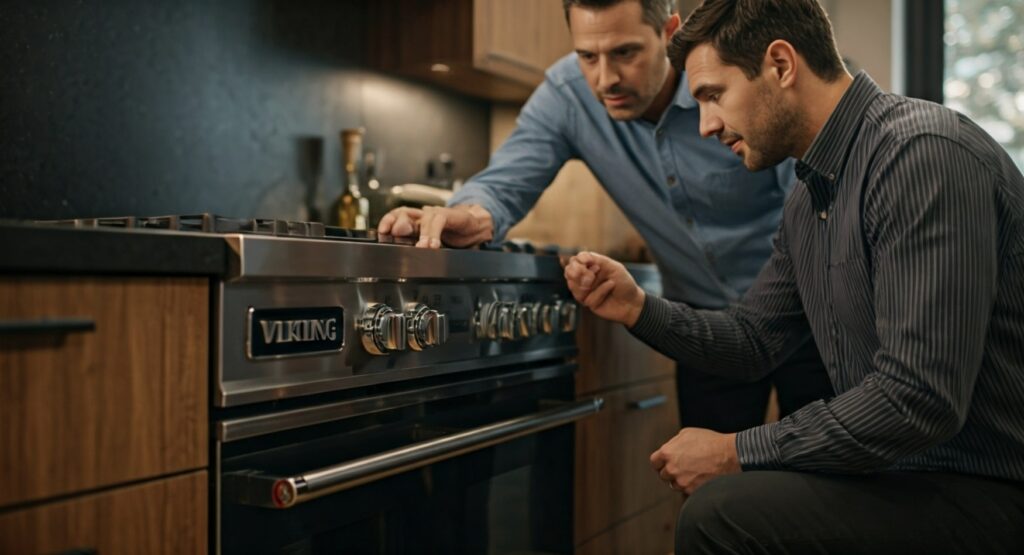Key Highlights
- A Viking refrigerator that runs all the time shows there may be some problems with how it works and how much energy it uses.
- Strange sounds, higher energy bills, and a warmer inside make it clear that something is wrong.
- Common reasons for these issues are dirty condenser coils, a broken defrost thermostat, and a faulty condenser fan motor.
- You can often figure out these problems using simple tools like a coil cleaning brush and a multimeter.
- Keeping up with regular maintenance, like cleaning the condenser coils once a year, can help avoid many typical refrigerator issues.
Introduction
A Viking refrigerator is a big investment meant to work well and last a long time. But just like any other appliance, it can have problems that affect its performance. A common issue is when the refrigerator keeps running all the time. This usually means there is a problem that needs fixing. In this guide, we will delve into why your Viking refrigerator runs constantly and what steps you can take to address this issue effectively. By understanding the common reasons behind this problem, you will be better equipped to troubleshoot and resolve the issue. Let’s begin unraveling the mystery of your tirelessly running refrigerator.
Identifying the Signs Your Viking Refrigerator Is Running Constantly
Modern refrigerators have energy-efficient compressors that run for a long time, but they should not run non-stop. It is important to notice the signs if a Viking refrigerator is running continually so you can take action quickly.
Unusual Noises and High Energy Bills
Refrigerator trouble signs include a constantly running compressor, which can stress and wear it out. Strange noises like clicking or grinding may indicate a fan motor issue. Watch for increased energy bills, a sign of your refrigerator working too hard. Ignoring these signs can lead to bigger repair costs. Act swiftly to address issues and keep your appliance running smoothly.
The Fridge’s Interior and Exterior Feel Warmer Than Usual
A change in refrigerator temperature may indicate issues with your Viking refrigerator. If food spoils quickly or the interior feels warm, something might be wrong. The refrigerator may struggle to maintain the set temperature, leading to constant operation. Feeling warmth on the sides or back signals potential problems with the condenser coils and fan motor, hindering heat release. These temperature fluctuations require immediate attention to prevent further issues like compressor failure and costly repairs.
Common Reasons Behind a Constantly Running Viking Refrigerator
Finding out why your Viking refrigerator keeps running is important for fixing it properly. Many things can cause this problem. These can be small maintenance mistakes or broken parts.
Dirty Condenser Coils and How They Affect Your Fridge
Dirty condenser coils can cause your Viking refrigerator to run constantly. These coils release heat from the refrigerant, crucial for cooling. Build-up of dust and dirt traps heat, making it difficult for the fridge to cool efficiently. This strains the compressor, leading to overheating and potential failure, necessitating costly repairs or a replacement.
Here’s why keeping the condenser coils clean is important:
- Best cooling performance: Clean coils let heat move easily, so your Viking refrigerator will run for shorter times.
- Lower energy use: When your fridge operates less, it uses less energy, helping you save money on your bills.
- Longer lifespan: By keeping the coils clean, you reduce strain on the compressor, which can help your refrigerator last longer.
Faulty Thermostat: Symptoms and Solutions
A faulty thermostat can cause your Viking refrigerator to run constantly by sending incorrect temperature signals to the compressor. This can lead to temperature fluctuations that may spoil or freeze your food.
It’s important to spot the signs of a faulty thermostat quickly:
- Wrong temperature readings: If the temperature in your Viking refrigerator is different from what the thermostat shows, there might be an issue.
- Refrigerator starts and stops too often: If this happens a lot, it can mean the thermostat can’t keep the right temperature.
- Frozen food inside the refrigerator: A thermostat that’s not working can make the fridge too cold, resulting in frozen food.
Beginner’s Guide to Diagnosing Your Viking Refrigerator
Diagnosing why your Viking refrigerator keeps running typically needs a few easy checks. Before thinking about serious problems or calling a repair person, try some simple steps by yourself.
What You’ll Need: Tools and Resources
Before you start fixing your fridge, make sure you have these important tools:
- Coil cleaning brush: Choose a long, flexible brush. This will help you reach small spaces and get rid of dust from the condenser coils.
- Vacuum cleaner with attachments: Use a vacuum with a crevice tool or a brush head. This makes it easier to remove loose dust and debris from the coils and nearby areas.
- Multimeter: A multimeter checks if electrical parts, like the thermostat and fan motor, work properly. This helps find possible problems.
- Screwdrivers: Keep a set of Phillips and flat-head screwdrivers ready. You’ll need them to take off panels and reach internal parts if necessary.
Always remember to unplug your Viking appliance before cleaning or doing any work to avoid electrical shock.
While these tools help with basic fixes, safety comes first. If you feel unsure about working with electrical appliances or think there is a more complex problem, it’s best to call a qualified technician for professional refrigerator repair.
Step 1: Checking the Condenser Coils for Dirt and Obstructions
Start your diagnosis by checking the condenser coils. These coils are usually at the back or underneath your Viking refrigerator. Carefully pull the appliance away from the wall. Make sure you have enough space to reach the coils.
Use your coil cleaning brush to gently clear away any dust, pet hair, or debris on the coils. If you find tough dirt, use a vacuum cleaner with a brush attachment for better cleaning. Keep in mind that dirty coils block airflow. This makes your refrigerator work harder and run all the time.
If cleaning the condenser coils solves the problem, great job! You have fixed a common refrigerator issue by yourself. If the problem does not go away, move on to the next step in the diagnostic process.
Step 2: Testing the Thermostat for Proper Functioning
If cleaning the condenser coils does not fix your Viking refrigerator that keeps running, the next step is to check the thermostat. The thermostat is very important for controlling the refrigerator’s temperature. It detects how warm it is inside and tells the compressor to turn on and off to keep it cool.
First, find the thermostat, which is usually behind a control panel inside the refrigerator. Check your appliance manual to find its exact spot. Once you find it, you can test if it works using a multimeter. Set the multimeter to the continuity setting and touch the probes to the thermostat’s terminals.
If you hear a continuous beep, that means the thermostat works well. If you hear no sound or only some beeping, the thermostat may be faulty and needs to be replaced. If you are not sure about working with electrical parts, check your refrigerator’s manual or get help from Viking Appliance Repair Pros for expert fridge repairs.
Conclusion
If your Viking refrigerator runs constantly, it might have dirty condenser coils or a broken thermostat. Keeping up with regular maintenance is important. This helps your fridge work well. If you find and fix these problems quickly, you can avoid high electric bills and repairs. Make sure to clean the condenser coils from time to time and check the thermostat to see if it works properly. For more troubleshooting tips, look at our guide on Troubleshooting Refrigerator Freezing Food Issues.
Frequently Asked Questions
What Makes a Viking Refrigerator Run All the Time?
A Viking refrigerator may run all the time for a few reasons. It could have dirty condenser coils. There might be a problem with the refrigerator compressor. The defrost system, either the thermostat or heater, could be faulty. Also, if the door seal is not tight, the fridge may need to work harder to keep the air inside cold.
How Often Should I Clean the Condenser Coils of My Refrigerator?
To keep your Viking refrigerator working well and to avoid putting stress on it, you should clean the condenser coils every three to six months. If you have pets or live in a dusty area, it’s a good idea to clean them more often. This helps with airflow and keeps the fridge cool efficiently.
What are the potential consequences of a refrigerator running constantly?
A refrigerator that runs all the time can raise your energy bills. It can also cause early damage to the appliance, particularly to the compressor. The internal temperatures may become uneven, which can harm food safety. If you ignore the problem for too long, you might face expensive refrigerator repair.






